I am trying to trim (take difference of) a polygon by another polygon.
I've created SpatialPolygons with the package sp, and I can use rgeos::gDifference (from https://gis.stackexchange.com/a/54146/171788) for a duplicated (but shifted) polygon, but it doesn't work for the polygon of the states from ggplot2 (see below).
## Load data
library("ggplot2")
states <- map_data("state") ## load state data
states<-states[states$region=="washington"|states$region=="oregon"|states$region=="california",] ## trim to continental west coast
## load data for primary polygon
WCG<-structure(list(X = c(665004L, 665232L, 661983L, 663266L, 660980L,
666562L, 660979L, 659316L, 661115L, 665803L, 663685L, 666535L,
667728L, 660758L, 661000L, 665903L, 664469L, 659077L, 665725L
), Survey = c("WCGBTS", "WCGBTS", "WCGBTS", "WCGBTS", "WCGBTS",
"WCGBTS", "WCGBTS", "WCGBTS", "WCGBTS", "WCGBTS", "WCGBTS", "WCGBTS",
"WCGBTS", "WCGBTS", "WCGBTS", "WCGBTS", "WCGBTS", "WCGBTS", "WCGBTS"
), Lat = c(33.07667, 32.91278, 32.70306, 32.57472, 32.0075, 31.99861,
32.01028, 32.28583, 32.38222, 32.81528, 40.13528, 40.25611, 48.07222,
48.175, 48.42278, 48.44444, 48.45083, 48.41556, 48.37028), Lon = c(-117.3383,
-117.2867, -117.2897, -117.3006, -118.3397, -118.6144, -118.8803,
-119.6567, -119.885, -120.2967, -125.07, -125.1383, -125.9614,
-125.9075, -125.1892, -124.9861, -124.8464, -124.7778, -124.755
), Date = c("7/15/2011", "7/17/2012", "7/17/2012", "7/17/2015",
"7/14/2010", "10/12/2016", "7/14/2010", "7/15/2007", "10/13/2010",
"10/9/2017", "6/22/2015", "9/18/2016", "5/29/2019", "5/26/2010",
"8/24/2010", "5/23/2017", "5/29/2009", "8/22/2007", "8/25/2017"
)), row.names = c(478258L, 478486L, 475237L, 476520L, 474234L,
479816L, 474233L, 472570L, 474369L, 479057L, 476939L, 479789L,
480982L, 474012L, 474254L, 479157L, 477723L, 472331L, 478979L
), class = "data.frame")
There is probably a simpler way to make polygons that can be subtracted from one another, but sp::Polygon doesn't work with rgeos::gDifference, so I convert to SpatialPolygons
library(sp)
WCGPoly<-Polygon(as.matrix(cbind(WCG$Lon,WCG$Lat)))
statesPoly<-Polygon(as.matrix(cbind(states$long,states$lat)))
crdref <- CRS('+proj=longlat +datum=WGS84')
p1 <- SpatialPolygons(list(Polygons(list(WCGPoly), "p1")),proj4string=crdref)
p2 <- SpatialPolygons(list(Polygons(list(statesPoly), "p2")),proj4string=crdref)
To visualize the difference we are trying to keep:
plot(p1,col="red")
plot(p2,add=T)
We want to keep the red that is off the west coast (not overlapped by the states).
library("rgeos")
Real <- gDifference(p1,p2)
Here I get a huge output, with errors:
p2 is invalid
Input geom 1 is INVALID: Self-intersection at or near point -122.33795166 48.281641190312918 (-122.33795166000000165 48.2816411903129179)
<A>
...
Error in RGEOSBinTopoFunc(spgeom1, spgeom2, byid, id, drop_lower_td, unaryUnion_if_byid_false, :
TopologyException: Input geom 1 is invalid: Self-intersection at -122.33795166 48.281641190312918
In addition: Warning messages:
1: In RGEOSUnaryPredFunc(spgeom, byid, "rgeos_isvalid") :
Self-intersection at or near point -122.33795166 48.281641190312918
2: In gDifference(p1, p2) :
Invalid objects found; consider using set_RGEOS_CheckValidity(2L)
I am assuming this is because the state polygon isn't one cohesive polygon (state borders are intact somehow and lines intersect one another, even though I only fed Lat/Lon to Polygon.
If I create a test polygon just by shifting the initial polygon it works:
testPoly<-Polygon(as.matrix(cbind(WCG$Lon+1,WCG$Lat)))
p3 <- SpatialPolygons(list(Polygons(list(testPoly), "p3")),proj4string=crdref)
plot(p1,col="red")
plot(p3,add=T)
Test <- gDifference(p1,p3)
plot(Test,col="red")
I've tried combining the "states" polygon with various forms of "union" functions (https://gis.stackexchange.com/a/63696/171788, https://gis.stackexchange.com/a/385360/171788), but this doesn't really make sense to me because most examples are using two distinct polygons, not a polygon with multiple "separated" areas like these states.
Trying this different answer (https://gis.stackexchange.com/a/169597/171788):
x<- p1-p2
x<- erase(p1,p2)
I get the following error:
x is invalid
Attempting to make x valid by zero-width buffering
Warning message:
In RGEOSUnaryPredFunc(spgeom, byid, "rgeos_isvalid") :
Self-intersection at or near point -122.33795166 48.281641190312918
Which again is telling me that my states polygon has a self-intersection. Is there a better way to trim my original polygon by the North American continent?
I've posted another (related) question here (How to use `polyclip::polysimplify` on a polygon) to understand how I might get rid of this self-intersection and create a solid polygon.
Any pointers would be greatly appreciated.









